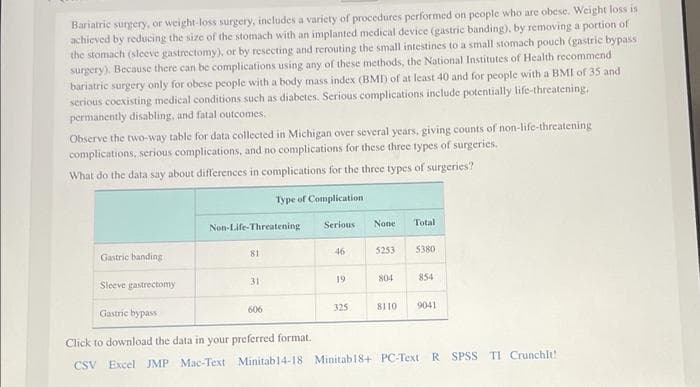Bariatric surgery, or weight-loss surgery, includes a variety of procedures performed on people who are obese. Weight loss is achieved by reducing the size of the stomach with an implanted medical device (gastric banding), by removing a portion of the stomach (sleeve gastrectomy), or by resecting and rerouting the small intestines to a small stomach pouch (gastric bypas surgery), Because there can be complications using any of these methods, the National Institutes of Health recommend bariatric surgery only for obese people with a body mass index (BMI) of at least 40 and for people with a BMI of 35 and serious coexisting medical conditions such as diabetes. Serious complications include potentially life-threatening. permanently disabling, and fatal outcomes. Observe the two-way table for data collected in Michigan over several years, giving counts of non-life-threatening complications, serious complications, and no complications for these three types of surgeries. What do the data say about differences in complications for the three types of surgeries? Type of Complication Non-Life-Threatening Serious None Total Gastric banding 81 46 5253 5380 Sleeve gastrectomy 31 19 804 854 Gastric bypass 606 325 8110 9041 Click to download the data in your preferred format. CSV Excel JMP Mac-Text Minitab14-18 Minitab18+ PC-Text R SPSS TI Crunchlt!
Bariatric surgery, or weight-loss surgery, includes a variety of procedures performed on people who are obese. Weight loss is achieved by reducing the size of the stomach with an implanted medical device (gastric banding), by removing a portion of the stomach (sleeve gastrectomy), or by resecting and rerouting the small intestines to a small stomach pouch (gastric bypas surgery), Because there can be complications using any of these methods, the National Institutes of Health recommend bariatric surgery only for obese people with a body mass index (BMI) of at least 40 and for people with a BMI of 35 and serious coexisting medical conditions such as diabetes. Serious complications include potentially life-threatening. permanently disabling, and fatal outcomes. Observe the two-way table for data collected in Michigan over several years, giving counts of non-life-threatening complications, serious complications, and no complications for these three types of surgeries. What do the data say about differences in complications for the three types of surgeries? Type of Complication Non-Life-Threatening Serious None Total Gastric banding 81 46 5253 5380 Sleeve gastrectomy 31 19 804 854 Gastric bypass 606 325 8110 9041 Click to download the data in your preferred format. CSV Excel JMP Mac-Text Minitab14-18 Minitab18+ PC-Text R SPSS TI Crunchlt!
Chapter6: Systems Of Equations And Inequalities
Section: Chapter Questions
Problem 17PS: Cholesterol Cholesterol in human blood is necessary, but too much can lead to health problems. There...
Related questions
Question
Please Solve In 20mins

Transcribed Image Text:Bariatric surgery, or weight-loss surgery, includes a variety of procedures performed on people who are obese. Weight loss is
achieved by reducing the size of the stomach with an implanted medical device (gastric banding), by removing a portion of
the stomach (sleeve gastrectomy), or by resecting and rerouting the small intestines to a small stomach pouch (gastric bypass
surgery). Because there can be complications using any of these methods, the National Institutes of Health recommend
bariatric surgery only for obese people with a body mass index (BMI) of at least 40 and for people with a BMI of 35 and
serious coexisting medical conditions such as diabetes. Serious complications include potentially life-threatening.
permanently disabling, and fatal outcomes.
Observe the two-way table for data collected in Michigan over several years, giving counts of non-life-threatening
complications, scrious complications, and no complications for these three types of surgeries.
What do the data say about differences in complications for the three types of surgeries?
Type of Complication
Non-Life-Threatening
Serious
None
Total
Gastric banding
81
46
5253
5380
Sleeve gastrectomy
804
854
31
19
Gastric bypass
606
325
8110
9041
Click to download the data in your preferred format.
CSV Excel JMP Mac-Text Minitab14-18 Minitab18+ PC-Text R SPSS TI Crunchlt!

Transcribed Image Text:PLAN Step: What specific statistical operations does this problem call for and why?
The goal is to determine whether or not there is an association (relationship) between the type of complication and the
type of surgery.
O Calculate the mean and standard deviation for each variable.
Compare the conditional distributions using a segmented bar graph or a mosaic plot.
O Construct side-by-side histograms or side-by-side boxplots for the three treatments grouped by the type of
complication.
O Calculate the conditional distributions of the type of complication for each of the three treatments.
Expert Solution
This question has been solved!
Explore an expertly crafted, step-by-step solution for a thorough understanding of key concepts.
This is a popular solution!
Trending now
This is a popular solution!
Step by step
Solved in 3 steps

Recommended textbooks for you

